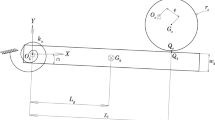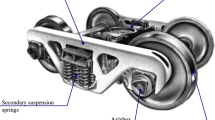Abstract
Rolling–sliding contacts are found in a variety of systems, such as gears, drum brakes, and tire pavements. Such systems inherently have multiple nonlinearities such as kinematic, contact, and friction nonlinearities. Further, most of these systems have clearance between components which causes excessive vibration and noise. The combination of clearance with other nonlinearities makes the system dynamically interesting. It is important to understand the dynamic behavior of such systems under various operating conditions. Hence, this article focuses on theoretically investigating the transient and steady-state responses of a cam–follower system with rolling–sliding contact and clearance as an exemplary case. A contact mechanics-based model for the same has been developed for this purpose. The transient behavior of the system is examined based on energy and time-varying frequency contents. The domain of attractors, frequency response plots, and phase portraits are deployed to analyze the effect of initial conditions and excitation speed on the steady-state behavior, quantitatively and qualitatively. The steady-state solutions were classified into various branches based on periodicity and phase portraits. In addition, parametric analyses of the effects of loading, damping, and friction on the response have been conducted. Finally, the system is examined for start-up and shut-down characteristics with a constant rate of change in excitation frequency.




















Similar content being viewed by others
Data availability
All necessary data needed to generate the results obtained in this study have been included in the article.
References
Comparin, R., Singh, R.: Non-linear frequency response characteristics of an impact pair. J. Sound Vib. 134(2), 259–290 (1989). https://doi.org/10.1016/0022-460X(89)90652-4
Telliskivi, T.: Simulation of wear in a rolling-sliding contact by a semi-winkler model and the Archard’s wear law. Wear 256(7–8), 817–831 (2004). https://doi.org/10.1016/S0043-1648(03)00524-6
Sudeep, U., Tandon, N., Pandey, R.: Performance of lubricated rolling/sliding concentrated contacts with surface textures: a review. J. Tribol. (2015). https://doi.org/10.1115/1.4029770
Tyfour, W., Beynon, J., Kapoor, A.: Deterioration of rolling contact fatigue life of pearlitic rail steel due to dry-wet rolling-sliding line contact. Wear 197(1–2), 255–265 (1996). https://doi.org/10.1016/0043-1648(96)06978-5
Beagley, T.: Severe wear of rolling/sliding contacts. Wear 36(3), 317–335 (1976). https://doi.org/10.1016/0043-1648(76)90110-1
Morales-Espejel, G.E., Brizmer, V.: Micropitting modelling in rolling-sliding contacts: application to rolling bearings. Tribol. Trans. 54(4), 625–643 (2011). https://doi.org/10.1080/10402004.2011.587633
O’donoghue, J., Cameron, A.: Friction and temperature in rolling sliding contacts. ASLE Trans. 9(2), 186–194 (1966). https://doi.org/10.1080/05698196608972134
Ramalho, A., Esteves, M., Marta, P.: Friction and wear behaviour of rolling-sliding steel contacts. Wear 302(1–2), 1468–1480 (2013). https://doi.org/10.1016/j.wear.2012.12.008
Baek, K.-S., Kyogoku, K., Nakahara, T.: An experimental investigation of transient traction characteristics in rolling-sliding wheel/rail contacts under dry-wet conditions. Wear 263(1–6), 169–179 (2007). https://doi.org/10.1016/j.wear.2007.01.067
Kahraman, A., Singh, R.: Non-linear dynamics of a spur gear pair. J. Sound Vib. 142(1), 49–75 (1990). https://doi.org/10.1016/0022-460X(90)90582-K
Kahraman, A., Blankenship, G.W.: Interactions between commensurate parametric and forcing excitations in a system with clearance. J. Sound Vib. 194(3), 317–336 (1996). https://doi.org/10.1006/jsvi.1996.0361
Blankenship, G., Kahraman, A.: Steady state forced response of a mechanical oscillator with combined parametric excitation and clearance type non-linearity. J. Sound Vib. 185(5), 743–765 (1995). https://doi.org/10.1006/jsvi.1995.0416
Kim, T., Rook, T., Singh, R.: Super-and sub-harmonic response calculations for a torsional system with clearance nonlinearity using the harmonic balance method. J. Sound Vib. 281(3–5), 965–993 (2005). https://doi.org/10.1016/j.jsv.2004.02.039
Zheng, X., Luo, W., Hu, Y., He, Z., Wang, S.: Study on the mesh stiffness and nonlinear dynamics accounting for centrifugal effect of high-speed spur gears. Mech. Mach. Theory 170, 104686 (2022). https://doi.org/10.1016/j.mechmachtheory.2021.104686
Kahraman, A., Blankenship, G.W.: Experiments on nonlinear dynamic behavior of an oscillator with clearance and periodically time-varying parameters (1997). https://doi.org/10.1115/1.2787276
Xia, Y., Pang, J., Yang, L., Chu, Z.: Investigation on clearance-induced vibro-impacts of torsional system based on hertz contact nonlinearity. Mech. Mach. Theory 162, 104342 (2021). https://doi.org/10.1016/j.mechmachtheory.2021.104342
Sundar, S., Dreyer, J.T., Singh, R.: Estimation of coefficient of friction for a mechanical system with combined rolling-sliding contact using vibration measurements. Mech. Syst. Signal Process. 58, 101–114 (2015). https://doi.org/10.1016/j.ymssp.2014.11.015
Alzate, R., Di Bernardo, M., Montanaro, U., Santini, S.: Experimental and numerical verification of bifurcations and chaos in cam-follower impacting systems. Nonlinear Dyn. 50(3), 409–429 (2007). https://doi.org/10.1007/s11071-006-9188-8
Chew, M., Chuang, C.: Minimizing residual vibrations in high-speed cam-follower systems over a range of speeds (1995). https://doi.org/10.1115/1.2826102
Ünlüsoy, Y.S., Tümer, S.T.: Non-linear dynamic model and its solution for a high speed cam mechanism with coulomb friction. J. Sound Vib. 169(3), 395–407 (1994). https://doi.org/10.1006/jsvi.1994.1025
Sundar, S., Dreyer, J.T., Singh, R.: Rotational sliding contact dynamics in a non-linear cam-follower system as excited by a periodic motion. J. Sound Vib. 332(18), 4280–4295 (2013). https://doi.org/10.1016/j.jsv.2013.02.035
Alzate, R., di Bernardo, M., Giordano, G., Rea, G., Santini, S.: Experimental and numerical investigation of coexistence, novel bifurcations, and chaos in a cam-follower system. SIAM J. Appl. Dyn. Syst. 8(2), 592–623 (2009). https://doi.org/10.1137/080723867
Cveticanin, L.: Stability of motion of the cam-follower system. Mech. Mach. Theory 42(9), 1238–1250 (2007). https://doi.org/10.1016/j.mechmachtheory.2006.08.004
Hamidzadeh, H., Dehghani, M.: Dynamic stability of flexible cam follower systems. Proc. Inst. Mech. Eng. Part K J. Multi-body Dyn. 213(1), 45–52 (1999). https://doi.org/10.1243/1464419991544045
Yousuf, L.S., Marghitu, D.B.: Non-linear dynamic analysis of a cam with flat-faced follower linkage mechanism. In: ASME International Mechanical Engineering Congress and Exposition, vol. 58370, pp. 04–05051 (2017). https://doi.org/10.1115/IMECE2017-71399. American Society of Mechanical Engineers
Yousuf, L.S.: Experimental and simulation investigation of nonlinear dynamic behavior of a polydyne cam and roller follower mechanism. Mech. Syst. Signal Process. 116, 293–309 (2019). https://doi.org/10.1016/j.ymssp.2018.06.028
Bahgat, B., Osman, M.: On the dynamic analysis of a cam mechanism with bearing clearances. In: The International Conference on Applied Mechanics and Mechanical Engineering, vol. 1, pp. 141–157 (1984). https://doi.org/10.21608/amme.1984.48797. Military Technical College
Sundar, S., Dreyer, J.T., Singh, R.: Estimation of impact damping parameters for a cam-follower system based on measurements and analytical model. Mech. Syst. Signal Process. 81, 294–307 (2016). https://doi.org/10.1016/j.ymssp.2016.02.033
Acknowledgements
We acknowledge the Science Engineering and Research Board (SERB), India (https://www.serbonline.in/) for partially supporting this research work under the Start-up Research Grant (Grant No. SRG/2019/001172).
Author information
Authors and Affiliations
Corresponding author
Ethics declarations
Conflict of interest
The authors have no relevant financial or non-financial interests to disclose.
Additional information
Publisher's Note
Springer Nature remains neutral with regard to jurisdictional claims in published maps and institutional affiliations.
Appendices
Appendix A: Nomenclature
\(\alpha \) | Angle made by the follower with \(\hat{e}_x\) |
(measured counter-clockwise) | |
\(\zeta \) | Damping ratio |
\(\theta \) | Angular displacement of cam \(\overrightarrow{EG}_c\) with \(\hat{e}_x\) |
(measured ccw) | |
\(\mu \) | Coefficient of friction |
\(\phi \) | Eccentricity of the cam, \(|\overrightarrow{EG_c}|\) |
\(\kappa \) | Stiffness of torsional spring |
\(\chi \) | Distance of contact point \(O_b\) from pivot (P) |
along follower length | |
\(\omega \) | Natural frequency (in contact) |
\(\Omega \) | Cam speed |
\(\psi (i,j)\) | Moving coordinate system on the follower at Q |
b | Backlash defined between the cam and follower |
C | Viscous damping coefficient |
E | Pivot point of the cam |
F | Force |
g | Acceleration due to gravity |
G | Geometric center |
I | Mass moment of inertia of follower about P |
K | Linear contact stiffness |
l | Length of the follower |
m | Mass of the follower |
n | Periodicity of the solutions (\(T/T_c\)) |
O | Contact point |
P | Pivot point of the follower |
Q | Location of contact point in kinematic zero |
state [21] | |
r | Radius of the cam |
t | Time |
T | Time period |
w | Width of the follower |
Subscripts | |
0 | Initial conditions |
a | Alternating |
b | Follower |
c | Cam |
f | Friction |
i | Component along \(\hat{i}\) |
j | Component along \(\hat{j}\) |
m | Mean |
N | Normal |
n | Natural |
p | Preload |
ss | Steady-state |
z | 0-to-peak amplitude |
Superscript | |
0 | Kinematic Zero state |
Appendix B: System parameters
Appendix C: Largest Lyapunov exponent
Appendix D: Effect of damping
Rights and permissions
Springer Nature or its licensor (e.g. a society or other partner) holds exclusive rights to this article under a publishing agreement with the author(s) or other rightsholder(s); author self-archiving of the accepted manuscript version of this article is solely governed by the terms of such publishing agreement and applicable law.
About this article
Cite this article
Suryawanshi, S., Sundar, S. Nonlinear dynamics of system with combined rolling–sliding contact and clearance. Nonlinear Dyn 111, 5023–5045 (2023). https://doi.org/10.1007/s11071-022-08127-6
Received:
Accepted:
Published:
Issue Date:
DOI: https://doi.org/10.1007/s11071-022-08127-6





